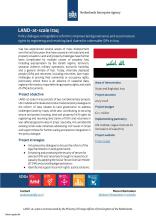Land Library Search
Through our robust search engine, you can search for any item of the over 73,000 highly curated resources in the Land Library.
If you would like to find an overview of what is possible, feel free to peruse the Search Guide.
/ library resources
Showing items 1 through 9 of 344.This one-pager provides details on the LAND-at-scale project in Iraq. This project is implemented by UN-Habitat and The Hague Institute for Innovation of Law (HIIL), and financed by the Ministry of Foreign Affairs via the Netherlands Enterprise & Development Agency (RVO).
Land is the key asset in the agricultural sector and hence land policy is one of the key elements that determine whether SDGs are achieved in developing counties or not. In developing countries, land titling programs have been seen as a strategy for addressing SDGs.
Despite the efforts of developed countries to protect undeveloped land, development continues to expand beyond urban boundaries. High-quality land needed for food production is often consumed.
Ensuring compliance with China’s “1.8 billion mu” (120 million hectares) cultivated land preservation policy is a fundamental goal of land policy.
Land expropriation has always been a hot spot of social conflicts. The land expropriation policy of Merging Villages and Living Together (MVLT) in rural areas has intensified conflicts due to insufficient financial compensation and “demolishing old houses before building new ones”.
In the Democratic Republic of Congo (DRC), entrepreneurship in the agriculture sector remains for youth a key pillar for income creation. However, few are attracted by agribusiness despite stakeholders’ efforts toward engaging youth in agriculture.
The growing population in informal settlements expedites alterations in land use and land cover (LULC) over time.
Arable land is the natural resource of food production, plays a key role in safe guarding people’s livelihood, maintaining social stability, and ecological balance.





